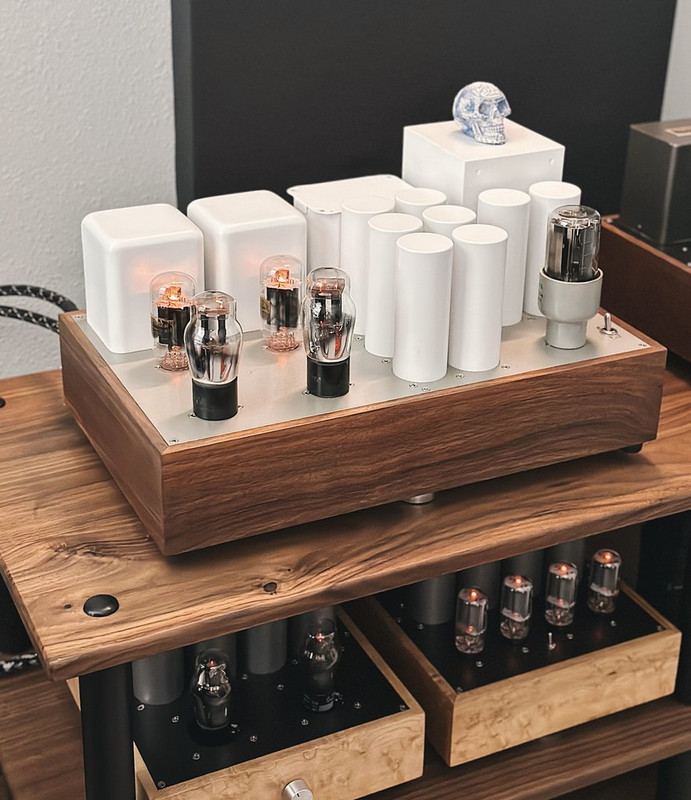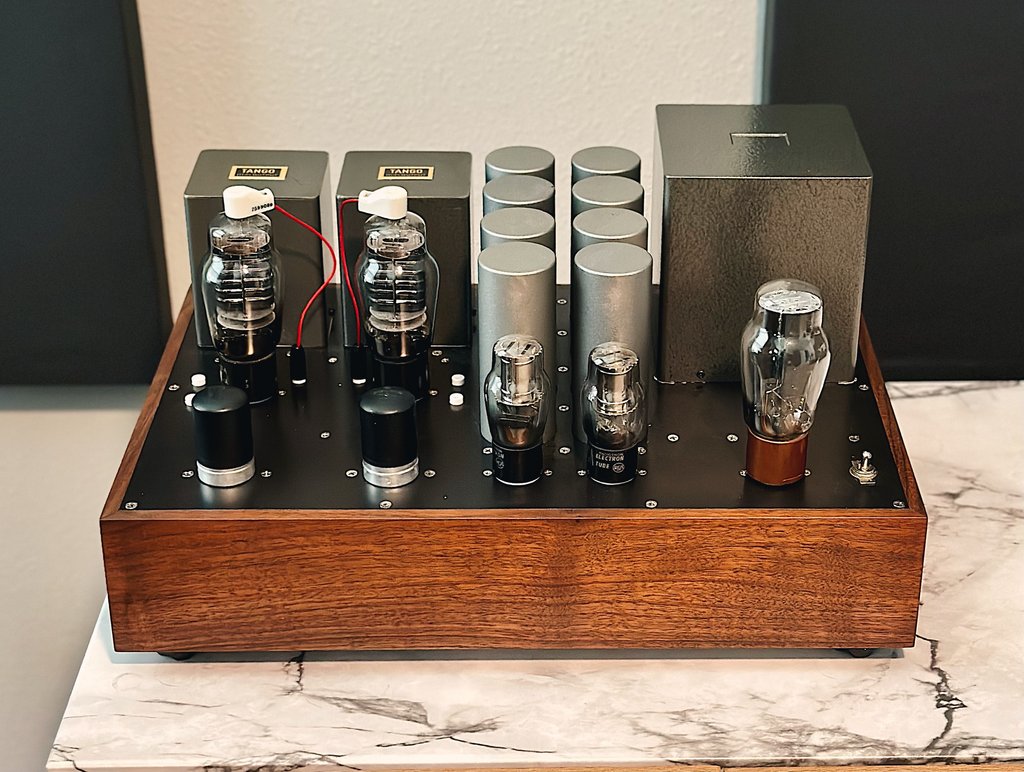Here's one of several of my bespoke SET's from Oliver Sayes
6HJ5, 6N7, 5R4WGB
UTC & Lundahl transformers, Duelund caps

nice what are your impressions of the differences of the models you had?
Here's one of several of my bespoke SET's from Oliver Sayes
6HJ5, 6N7, 5R4WGB
UTC & Lundahl transformers, Duelund caps

You are quite aware of the point that I am making Kedar …ok, clueless, many drivers in horns. Altec was never as high priced as GPA made it to be all of a sudden. And what makes you think Goto is better, have you heard any Goto 2-ways? They are almost always 4 or 5 ways as they are narrow bandwidth and have their own complexity
It’s an existing build. Ken said he worked a long time on this design and it’s his best price to performance 300B amp. It has a toggle to switch between PX25 and 300B.Love the simplicity of that amp. was is a custom request or an existing build from them? Still Ken?
very nice. may I ask how much?It’s an existing build. Ken said he worked a long time on this design and it’s his best price to performance 300B amp. It has a toggle to switch between PX25 and 300B.
nice what are your impressions of the differences of the models you had?

$2500 + shipping, no tubesvery nice. may I ask how much?
Beautiful to see… they look fantastic Kray. Lovely work.Here's one of several of my bespoke SET's from Oliver Sayes
6HJ5, 6N7, 5R4WGB
UTC & Lundahl transformers, Duelund caps

Beautiful to see… they look fantastic Kray. Lovely work.
I feel like I need this amp. How do I get one? Is there a website or a way to contact the builder?Good question. This 6HJ5 is similar in spec to a 2A3, but i can re-tube the whole amp for under $80. It also sounds VERY close to my Sayes 421a.
Had a 42, 45, & 46 from Sayes as well. Enjoyed them all but prob the 46 the most. It's always hard for me to remember how to compare the sound once they've been out of the house more than a year.
My current favorite is my 307a. tango transformers. Similar to 300B but tightened up bass and more 3D.
- C3M driver
- 5AR4 rectifier
- Regulated DC filament supplies
- 0D3 tube regulated screens
- Duelund copper caps
- DHT wired Tetrode output
- 6wpc
- Lundahl chokes
- Hirata Tango output transformers

I’ll PM youI feel like I need this amp. How do I get one? Is there a website or a way to contact the builder?
it gave me an itch as well...not ready to pull the trigger yet...I have plenty of good amps...however...I feel like I need this amp. How do I get one? Is there a website or a way to contact the builder?
Depending on how you have the input transformer wired, it can do either balanced or single-ended input quite well.hey are of course single ended triode design but they only have a balanced XLR input. I have almost no knowledge of electrical engineering but I do understand how a balanced/common mode rejection design works and thus know that if an amp is single ended, it cannot also be balanced, so I don't understand why such an amp would have an XLR as the input unless it was simply because the designer chose to use that connection for convenience.
I use adapters on my (long) IC cable runs, which are themselves RCA only, as is my pre-amp. I've asked my dealer who supplied the units a number of times but whilst he's given an explanation, I've never quite understood it. He says there is a transformer immediately behind the input which recombines the signal before passing it through the amplification stages. This makes sense but I still don't understand why you would do that rather than just use an RCA input and lose the transformer (which would simply add cost, unnecessarily it would seem).
Balanced connections are more than just fashion. They allow you to run really long interconnects without degradation (as in a microphone, but at line levels too), which allow you to placed your amps as close to the loudspeakers as possible. With SETs this is important, because they are more sensitive to speaker cables. This allows you to run as short speaker cables as possible (minimizing loss of bass impact and other colorations) without compromise on account of the long interconnects.This is the usual tribute to fashion. Balanced connection is necessary when transmitting weak signals over long distances, for example from a microphone from the stage, or in modern DACs. In this way, the level of noise that occurs in the chip during signal processing in DACs is reduced. A balanced signal can still simplify the design of the PP amplifier. It is not needed at all for the SE amplifier.
Class A SETs come in three varieties, class A1 (which is most of them), class A2 (grid current can be present during part of the signal waveform, which requires a more robust drive circuit) and class A3 (which was recently patented and also has grid current present). To my understanding class A3 offers the most power and the least distortion but the operating point is arcane and not understood by most designers.Can you give an example of a SE amplifier class other than class A?
Interesting, Ralph. Do you believe A3 offers significant 'base level' advantages as a design approach...so that it has perhaps (or is or will) tempt a designer like you to do an all-out assault design for it? Most power, least distortion...and all Class A seems like a great story....Class A SETs come in three varieties, class A1 (which is most of them), class A2 (grid current can be present during part of the signal waveform, which requires a more robust drive circuit) and class A3 (which was recently patented and also has grid current present). To my understanding class A3 offers the most power and the least distortion but the operating point is arcane and not understood by most designers.
Excellent. What transformers are in the amps?$2500 + shipping, no tubes
His own. He won’t tell you anything about them. Trade secret.Excellent. What transformers are in the amps?
His own. He won’t tell you anything about them. Trade secret.
Is it necessary? I have yet to see a home audio system in which the distance between the speakers is 20 meters or more. 3-4 meters between speakers, very long interconnects are not needed.Depending on how you have the input transformer wired, it can do either balanced or single-ended input quite well.
Balanced connections are more than just fashion. They allow you to run really long interconnects without degradation (as in a microphone, but at line levels too), which allow you to placed your amps as close to the loudspeakers as possible. With SETs this is important, because they are more sensitive to speaker cables. This allows you to run as short speaker cables as possible (minimizing loss of bass impact and other colorations) without compromise on account of the long interconnects.
Class A SETs come in three varieties, class A1 (which is most of them), class A2 (grid current can be present during part of the signal waveform, which requires a more robust drive circuit) and class A3 (which was recently patented and also has grid current present). To my understanding class A3 offers the most power and the least distortion but the operating point is arcane and not understood by most designers.
A3 does offer benefit, but Its not a thing in which I have a lot of interest. I like musicality, but since I've done a lot of recording and have been at the sessions I've recorded, I know what they are supposed to sound like, so I'm not a fan of colorations and for the last 50 years have tried to prevent them showing up in my designs. So far, having studied SETs since the early 1990s, I've not found a particular advantage they have over other topologies; for SETs, colorations seem to be the name of the game.Interesting, Ralph. Do you believe A3 offers significant 'base level' advantages as a design approach...so that it has perhaps (or is or will) tempt a designer like you to do an all-out assault design for it? Most power, least distortion...and all Class A seems like a great story.
The advantage of shorter speaker cables is an advantage; in addition to helping get the bass right, things like vocals will be more easily discerned. Even though the amplifier might have decent bass in itself, its high output impedance might otherwise pose a difficulty, especially if the OPT is used on a lower impedance tap! By using balanced lines, you can eliminate the colorations that so many single-ended cables impose (if you've auditioned two such cable side by side and heard a difference, that's exactly what I'm talking about), and one of those colorations can be a lack of bass; IOW I'm not concerned about adding bass rather not losing it. I play bass (since 6th grade) so I need to be convinced by the system's ability to play bass correctly.Is it necessary? I have yet to see a home audio system in which the distance between the speakers is 20 meters or more. 3-4 meters between speakers, very long interconnects are not needed.
Loss of bass should be considered when choosing an amplifier. Fist-sized output transformers will never produce quality bass. A balanced connection or long interconnects will not add bass.
(...) Balanced connections are more than just fashion. They allow you to run really long interconnects without degradation (as in a microphone, but at line levels too), which allow you to placed your amps as close to the loudspeakers as possible. With SETs this is important, because they are more sensitive to speaker cables. This allows you to run as short speaker cables as possible (minimizing loss of bass impact and other colorations) without compromise on account of the long interconnects. (...)
| Steve Williams Site Founder | Site Owner | Administrator | Ron Resnick Site Owner | Administrator | Julian (The Fixer) Website Build | Marketing Managersing |















